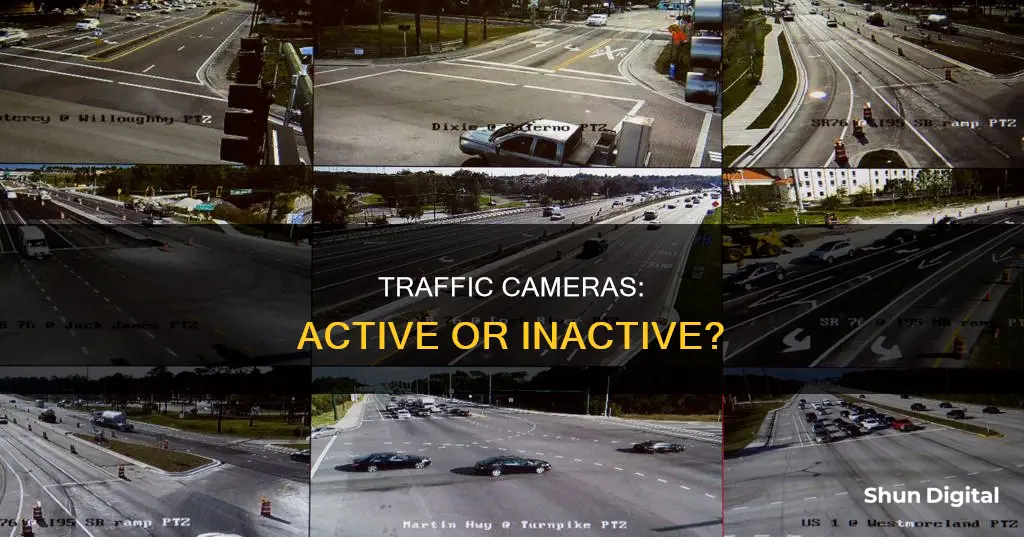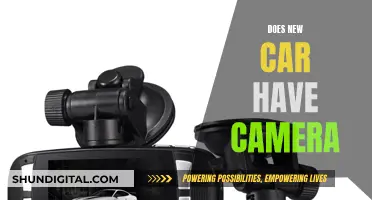
Traffic cameras are an increasingly common sight on roads across the globe. These cameras are usually mounted on poles or traffic lights and are used to monitor traffic patterns, enforce road rules, and improve road safety. While some traffic cameras are dummies, many are active and can record footage or capture images. This data can be used for a variety of purposes, from tracking the location of certain vehicles to issuing traffic citations. The use of traffic cameras is controversial, with some arguing that they improve road safety and others claiming that they are an invasion of privacy.
| Characteristics | Values |
|---|---|
| Purpose | To detect motoring offences, including speeding, red light running, toll booth avoidance, unauthorised use of bus lanes, or recording vehicles inside a congestion charge area. |
| Effectiveness | A worldwide review of studies found that speed cameras led to a reduction of 11% to 44% for fatal and serious injury crashes. |
| Privacy Concerns | The latest automatic number-plate recognition systems can be used for the detection of average speeds and raise concerns over loss of privacy and the potential for governments to establish mass surveillance of vehicle movements. |
| Dummy Cameras | Dummy cameras are used in some places to deter motorists from breaking the law. |
| Location | Mounted beside or over a road or installed in an enforcement vehicle. |
| Functionality | May be linked to an automated ticketing system. |
| Types | Red light cameras, speed cameras, bus lane cameras, noise pollution cameras, congestion charge cameras, high-occupancy vehicle lane cameras, level crossing cameras, parking cameras, toll-booth cameras, turn cameras. |
What You'll Learn

Red light cameras
The cameras are typically triggered by sensors installed in the road when a vehicle passes over the stop line and enters the intersection during a red light. The sensors may be single or dual inductive loops, piezoelectric strips, laser, radar, or optical video analyses. In some cases, the system may take multiple photographs or a video clip to capture the vehicle's progress through the intersection.
The photographic or video evidence is then reviewed by a law enforcement official to determine if a violation occurred. If a violation is confirmed, a citation or ticket is typically mailed to the owner of the vehicle. The fines for running a red light can vary depending on the location, ranging from \$50 in New York to approximately \$500 in California.
While red light cameras are designed to improve road safety and reduce collisions, there is ongoing debate and research about their effectiveness. Some studies suggest that while they may reduce side collisions, they can also lead to an increase in rear-end collisions as drivers may suddenly brake to avoid a ticket.
Surveillance Camera Footage: When Privacy Becomes Public
You may want to see also

Speed cameras
The UK has around 7,000 speed cameras, making it the fourth-highest in the world. There are over a dozen different types of speed cameras in operation, including fixed and mobile cameras. Fixed speed cameras are typically mounted on poles or structures, while mobile speed cameras can be handheld devices or placed within vans.
Not all speed cameras are active. In fact, research suggests that only about half of the speed cameras in the UK are operational. This varies by region, with some areas having no working speed cameras at all. For example, a Freedom of Information (FOI) request in 2017 revealed that out of 2,838 cameras, only 1,486 were active. More recent FOI requests by BBC Panorama in 2024 found that out of 1,092 fixed camera sites, only 523 were functional, indicating that the situation may not have improved significantly.
The inactivity of speed cameras can be attributed to technological changes and funding issues. When the old-style yellow box cameras were introduced in the 1990s, they used traditional film, which was time-consuming and expensive to develop. With the advent of digital technology, many regions could not afford to upgrade the cameras due to budget cuts and changes in funding allocation.
Despite the number of inactive speed cameras, it's important to remember that mobile speed cameras and other enforcement methods are still in use. The best way to avoid penalties and stay safe is to adhere to speed limits.
Car Rental Privacy: Cameras in National Rentals?
You may want to see also

Dummy cameras
However, the use of dummy cameras is controversial. Some argue that inactive cameras serve no real purpose and can be more distracting than helpful to drivers. If drivers are unsure whether a camera is active, it may confuse or distract them, potentially increasing the risk of collisions. There are also concerns about the potential for governments to use active cameras for mass surveillance of vehicle movements and, by association, the movements of vehicle owners.
In some places, like Britain, campaigners are calling for the removal of all inactive speed cameras to avoid potential confusion and accidents. In contrast, other places, like France, are installing thousands of dummy cameras to expand their speed camera programme and improve road safety.
While dummy cameras may have their benefits, it is essential to consider the potential drawbacks and implement them carefully to ensure they do not cause more harm than good.
Understanding Computer Cameras: What Are They?
You may want to see also

Traffic sensor cameras
The placement of traffic sensor cameras is strategic, typically at intersections, on-ramps, and other areas with heavy or congested traffic. Once deployed, the cameras are connected to a control center or network, where their images can be viewed and analysed in real time by traffic engineers or law enforcement personnel. This allows for prompt action in case of accidents or disruptions.
While traffic sensor cameras are not used for enforcement, other types of traffic cameras, such as red light cameras and speed cameras, are designed for automated ticket issuance when traffic rules are violated. However, it's important to note that the presence of cameras at traffic signals does not always indicate enforcement capabilities, as many of them are traffic sensor cameras with a different purpose.
Replacing Your Vivint Doorbell Camera Battery: A Step-by-Step Guide
You may want to see also

Automated Number Plate Recognition (ANPR) cameras
ANPR cameras can be either mobile or fixed. Mobile ANPR cameras are usually mounted on police cruisers, while fixed cameras are mounted on poles or other structures. They are used by police forces around the world for law enforcement purposes, such as checking if a vehicle is registered or licensed, and can also be used for electronic toll collection and cataloguing traffic movements.
One of the benefits of ANPR cameras is their ability to operate in low-light conditions. Many ANPR cameras use infrared lighting, which is invisible to the human eye but detectable by camera sensors, to capture clear images of license plates at night or in challenging lighting environments.
However, there are also some issues with ANPR cameras. One of the main concerns is privacy, as ANPR cameras can be used for government tracking of citizens' movements, leading to criticisms of mass surveillance. Additionally, ANPR cameras may have issues with blurry images, incorrect readings, and unreliable data, especially when the camera is too far away from the vehicle or mounted improperly.
To optimize the performance of ANPR cameras, it is important to consider factors such as camera resolution, infrared capabilities, camera angle, and shutter speed. By adjusting these factors and following best practices for camera setup, the accuracy and reliability of ANPR systems can be significantly improved.
The Dynamic Duo: Camera Car and Spotter Drivers Explained
You may want to see also
Frequently asked questions
Traffic cameras are used to monitor and enforce compliance with road rules, including speeding, red-light running, toll booth avoidance, and unauthorized use of bus lanes. They can also be used to record vehicles inside congestion charge areas and detect average speeds.
Traffic cameras vary in appearance depending on their type and purpose. Red light cameras tend to be bulkier with a large camera box and two external flashes mounted on poles, while ANPR cameras are usually small and consist of just one or two modules. Traffic sensor cameras are typically small, cylindrical, or dome-shaped and enclosed in a weatherproof housing.
Traffic cameras are typically placed at busy intersections, on traffic signals or poles, or mounted high on light poles above roadways. Red light cameras are often found in urban areas, while speed cameras are more common on back roads and in residential areas.
No, not all traffic cameras are always active. Some cameras only activate under specific conditions, such as when a vehicle runs a red light or exceeds the speed limit. Additionally, some cameras are dummy cameras, like those used in New York, which are not hooked up to anything or recording.







